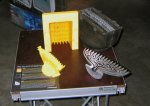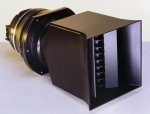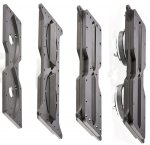Re: Infocomm???
Virtually every modular line array box on the market (with the notable exception of the digitally steerable boxes), both constant curvature units and variable curvature units, relies on narrow horns for the top end of the box. So for at least some of the operating band of the box, there is nominally no destructive interference if the boxes are at maximum splay (in the real world, no horns have perfect cutoff outside the pattern).
Hi
As Harry Olsen inventor of the line array said about 80 years ago “neither straight or curved is correct” (for a broad band signal) and while it’s true that what are now called line arrays aren’t actually line sources in the acoustic sense, it is because actual line sources have such strong aberrations and frequency dependant behavior that the solution is to try to make them astigmatic point sources instead.
Robs comment on narrow horns is exactly what the advertising would make one think and at the very top, they are narrow in the vertical or could be anyway.
Some manufacturers go so far as to show the vertical beam width measurements which reveal the actual behavior. Horns can and do confine sound to a given angle and some can do this at a fixed angle over some range of frequency BUT this is a size dependant thing. Don Keele came up with a neat thumb rule which is pretty accurate and gives one a way to estimate what a given horn will do so far as where it will loose pattern control.
It can be parsed several ways but if one has the height at the mouth and the horn wall angle, the pattern loss frequency is ;
F = 10^6 / (height in inches X angle)
So for a horn 12 inches tall and a horn wall angle of 5 degrees, the pattern loss frequency is 16.6Khz, if it were a 10 degree horn it would lose pattern control an octave lower at 8.33Khz.
One might think that stacking many together would act like a single larger horn but this too is mostly line array folk lore, acoustic sources can add coherently into one new source but only if they are less than ¼ wavelength apart, once they reach ½ wl (the dimension many line array papers refer to) or more, they radiate as independent sources, have no mutual coupling and produce an interference pattern (lobes and nulls in the polar pattern which is comb filtering as seen in 3d). When one has an interference pattern, you have a system which projects a different spectral balance at every location and one that will have a limited “throw” so far as listen ability and inferior intelligibility when measured with STIpa.
It is the interference pattern one hears moving around when a line array is in the wind and while it is said that when the interference pattern is dense enough it is inaudible, it is audible when transients are part of the signal. It is then argued that with DSP one can fix that and this part is true at least in one single location but everywhere else, the path lengths are different and the DSP correction for one location is not applicable.
Further, some mfrs correctly explain line arrays work on constructive and destructive interference and the Huygens wavefront construction cartoons often used to explain how many close coupled direct sources radiate as a line, usually forgets to include that each source while producing a summed wavefront also continues to radiate the same amount of energy to the sides, up and down as each element does singly and so compared to a large horn, the line array radiates much more energy outside the intended pattern. It is the destructive interference that makes it necessary to use so many more drivers and amplifiers for a given task.
This is why most “line arrays” when measured act like, measure like multiple sources in time, each with it’s own arrival in time according to it’s distance to the listener.
They distort the time related sonic information by spreading it out in time and the larger the array, the less faithful to the input signal they are.
Peter is correct on his observation on the J-3, it is also an astigmatic point source however all of the drivers interact when they are less than ¼ wl apart and add coherently with no interference and DO sum into what measures like, sounds like a single horn loaded full range driver in a constant directivity horn. That is why they sound the same far away as up close and wind has essentially no audible effect on the sound, unlike the line arrays, there is no interference pattern or distance where the spectral balance changes limiting the “throw”.
I know this would be hard to believe especially since we do not try to sell into live sound but right now half of the largest stadiums in the USA use our full range single point horns and two more coming next season and this isn’t because of marketing or discounting, it is because of the dramatic difference in sound quality and intelligibility when heard side by side with the line arrays like used in concert sound.
By using full range horn loading and constant directivity, one can do these jobs with far fewer drivers, cabinets and amplification and radiating from a single point in time one gets a much better sonic result as well as immunity of sonic issues with the wind blowing. Here is a well known fellow who found that even with a smaller Synergy horn than the stadium stuff, note what he said about the wind and even coverage and how many boxes they normally used
https://www.merlijnvanveen.nl/index.php/en/study-hall/90-danley-sound-labs-case-study
If you have headphones handy, I can at least illustrate what I am talking about, plug them into the computer and try some stadium video’s that demonstrate what I am talking about.
This system is in the scoreboard at the far end (700 feet away)
https://www.dropbox.com/s/tnsw5mb4v5vdlwq/20120726122124.mts?dl=0
A larger scoreboard system that can do 106dBA slow at 800 feet and has a -3dB point at 27Hz.
https://www.dropbox.com/s/oyosfc3adc6j1du/20130723135350.mts?dl=0
https://www.dropbox.com/s/ykq1y2ugesok2se/20130723141759.mts?dl=0
My daughter at patterns edge in a stiff crosswind at about 400 feet
https://www.dropbox.com/s/dz224imtchuohi4/20130723145400.mts?dl=0
An even larger system at 800 feet
https://www.dropbox.com/s/lyjf0p46163q4es/20140805175937.mts?dl=0
the field coverage speaker (1 j-3) at the 50 yard line
https://www.dropbox.com/s/mxa64hkkhkk07vj/20140805133848.mts?dl=0
The demo that lead to the replacement of a 3 year old well known line array, the speakers are the little black glob under the scoreboard. Clair bros the installer measured + -2 dB over the stadium and “it sounds the same everywhere”.
https://www.youtube.com/watch?v=e_usTlJi2NA&feature=share
These are probably not what you’re used to and until the patents expire, it’s our technology.
David, the mono phantom is what one hears when sitting near the center and has a mono signal, thankfully the recording engineers and Disney folks heard it clearly enough to come up and talk to me about it. Next time come up and say Hi.
Best,
Tom Danley
Danley Sound Labs





